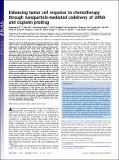| dc.contributor.author | Xu, Xiaoyang | |
| dc.contributor.author | Xie, Kun | |
| dc.contributor.author | Zhang, Xue-Qing | |
| dc.contributor.author | Pridgen, Eric M. | |
| dc.contributor.author | Park, Ga Young | |
| dc.contributor.author | Cui, Danica S. | |
| dc.contributor.author | Shi, Jinjun | |
| dc.contributor.author | Kantoff, Philip W. | |
| dc.contributor.author | Lippard, Stephen J. | |
| dc.contributor.author | Walker, Graham C. | |
| dc.contributor.author | Farokhzad, Omid C. | |
| dc.contributor.author | Langer, Robert S | |
| dc.contributor.author | Wu, Jun | |
| dc.date.accessioned | 2014-08-28T15:36:57Z | |
| dc.date.available | 2014-08-28T15:36:57Z | |
| dc.date.issued | 2013-11 | |
| dc.date.submitted | 2013-03 | |
| dc.identifier.issn | 0027-8424 | |
| dc.identifier.issn | 1091-6490 | |
| dc.identifier.uri | http://hdl.handle.net/1721.1/89085 | |
| dc.description.abstract | Cisplatin and other DNA-damaging chemotherapeutics are widely used to treat a broad spectrum of malignancies. However, their application is limited by both intrinsic and acquired chemoresistance. Most mutations that result from DNA damage are the consequence of error-prone translesion DNA synthesis, which could be responsible for the acquired resistance against DNA-damaging agents. Recent studies have shown that the suppression of crucial gene products (e.g., REV1, REV3L) involved in the error-prone translesion DNA synthesis pathway can sensitize intrinsically resistant tumors to chemotherapy and reduce the frequency of acquired drug resistance of relapsed tumors. In this context, combining conventional DNA-damaging chemotherapy with siRNA-based therapeutics represents a promising strategy for treating patients with malignancies. To this end, we developed a versatile nanoparticle (NP) platform to deliver a cisplatin prodrug and REV1/REV3L-specific siRNAs simultaneously to the same tumor cells. NPs are formulated through self-assembly of a biodegradable poly(lactide-coglycolide)-b-poly(ethylene glycol) diblock copolymer and a self-synthesized cationic lipid. We demonstrated the potency of the siRNA-containing NPs to knock down target genes efficiently both in vitro and in vivo. The therapeutic efficacy of NPs containing both cisplatin prodrug and REV1/REV3L-specific siRNAs was further investigated in vitro and in vivo. Quantitative real-time PCR results showed that the NPs exhibited a significant and sustained suppression of both genes in tumors for up to 3 d after a single dose. Administering these NPs revealed a synergistic effect on tumor inhibition in a human Lymph Node Carcinoma of the Prostate xenograft mouse model that was strikingly more effective than platinum monotherapy. | en_US |
| dc.description.sponsorship | Prostate Cancer Foundation (Award in Nanotherapeutics) | en_US |
| dc.description.sponsorship | National Cancer Institute (U.S.). Centers of Cancer Nanotechnology Excellence | en_US |
| dc.description.sponsorship | National Institutes of Health (U.S.) (Grant CA151884) | en_US |
| dc.description.sponsorship | National Institute of Environmental Health Sciences (Grant ES015818) | en_US |
| dc.description.sponsorship | National Institutes of Health (U.S.) (National Research Service Award Grant 1F32CA168163-01)) | en_US |
| dc.language.iso | en_US | |
| dc.publisher | National Academy of Sciences (U.S.) | en_US |
| dc.relation.isversionof | http://dx.doi.org/10.1073/pnas.1303958110 | en_US |
| dc.rights | Article is made available in accordance with the publisher's policy and may be subject to US copyright law. Please refer to the publisher's site for terms of use. | en_US |
| dc.source | PNAS | en_US |
| dc.title | Enhancing tumor cell response to chemotherapy through nanoparticle-mediated codelivery of siRNA and cisplatin prodrug | en_US |
| dc.type | Article | en_US |
| dc.identifier.citation | Xu, X., K. Xie, X.-Q. Zhang, E. M. Pridgen, G. Y. Park, D. S. Cui, J. Shi, et al. “Enhancing Tumor Cell Response to Chemotherapy through Nanoparticle-Mediated Codelivery of siRNA and Cisplatin Prodrug.” Proceedings of the National Academy of Sciences 110, no. 46 (October 28, 2013): 18638–18643. | en_US |
| dc.contributor.department | Massachusetts Institute of Technology. Department of Biology | en_US |
| dc.contributor.department | Massachusetts Institute of Technology. Department of Chemical Engineering | en_US |
| dc.contributor.department | Massachusetts Institute of Technology. Department of Chemistry | en_US |
| dc.contributor.department | Koch Institute for Integrative Cancer Research at MIT | en_US |
| dc.contributor.mitauthor | Xu, Xiaoyang | en_US |
| dc.contributor.mitauthor | Xie, Kun | en_US |
| dc.contributor.mitauthor | Pridgen, Eric M. | en_US |
| dc.contributor.mitauthor | Park, Ga Young | en_US |
| dc.contributor.mitauthor | Lippard, Stephen J. | en_US |
| dc.contributor.mitauthor | Langer, Robert | en_US |
| dc.contributor.mitauthor | Walker, Graham C. | en_US |
| dc.relation.journal | Proceedings of the National Academy of Sciences | en_US |
| dc.eprint.version | Final published version | en_US |
| dc.type.uri | http://purl.org/eprint/type/JournalArticle | en_US |
| eprint.status | http://purl.org/eprint/status/PeerReviewed | en_US |
| dspace.orderedauthors | Xu, X.; Xie, K.; Zhang, X.-Q.; Pridgen, E. M.; Park, G. Y.; Cui, D. S.; Shi, J.; Wu, J.; Kantoff, P. W.; Lippard, S. J.; Langer, R.; Walker, G. C.; Farokhzad, O. C. | en_US |
| dc.identifier.orcid | https://orcid.org/0000-0002-1634-3329 | |
| dc.identifier.orcid | https://orcid.org/0000-0002-2693-4982 | |
| dc.identifier.orcid | https://orcid.org/0000-0001-7243-8261 | |
| dc.identifier.orcid | https://orcid.org/0000-0003-4255-0492 | |
| mit.license | PUBLISHER_POLICY | en_US |
| mit.metadata.status | Complete | |
